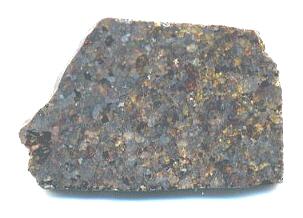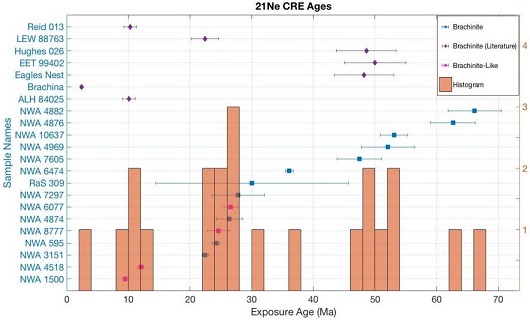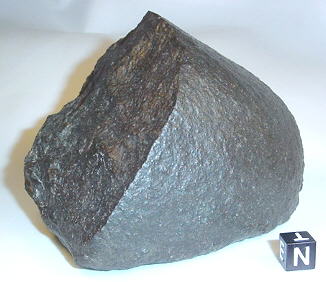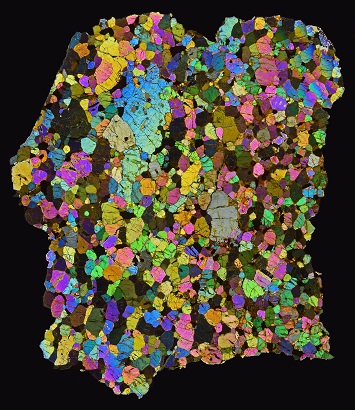Brachinite

Purchased April 2005
no coordinates recorded A single fusion-crusted stone weighing 1,500 g was found in Morocco or Algeria. The meteoriteWork in progress. A solid natural object reaching a planet’s surface from interplanetary space. Solid portion of a meteoroid that survives its fall to Earth, or some other body. Meteorites are classified as stony meteorites, iron meteorites, and stony-iron meteorites. These groups are further divided according to their mineralogy and Click on Term to Read More was subsequently purchased by G. Hupé while visiting in Morocco. A type specimen was submitted for analysis to the University of Washington in Seattle (A. Irving and S. Kuehner), and NWA 3151 was classified as a brachinite, the largest member of the group found to date. A separate 26.5 g stone, NWA 5191, has been determined to be a possible pairing to NWA 3151 (A. Ibhi, LPMM, and M. vanGinneken and L. Folco, MNA-SI).
Northwest Africa 3151 is a coarse-grained (0.7–1.6 mm), olivine-rich (~95 vol%) dunite (Irving
et al., 2005). It contains minor clinopyroxene, FeNi-metal,
chromiteBrownish-black oxide of chromium and iron (Cr-Fe oxide), Cr2FeO4, found in many meteorite groups. Click on Term to Read More, and
troiliteBrass colored non-magnetic mineral of iron sulfide, FeS, found in a variety of meteorites. Click on Term to Read More, and rare sodic
plagioclaseAlso referred to as the plagioclase feldspar series. Plagioclase is a common rock-forming series of feldspar minerals containing a continuous solid solution of calcium and sodium: (Na1-x,Cax)(Alx+1,Si1-x)Si2O8 where x = 0 to 1. The Ca-rich end-member is called anorthite (pure anorthite has formula: CaAl2Si2O8) and the Na-rich end-member is albite Click on Term to Read More and
orthopyroxeneOrthorhombic, low-Ca pyroxene common in chondrites. Its compositional range runs from all Mg-rich enstatite, MgSiO3 to Fe-rich ferrosilite, FeSiO3. These end-members form an almost complete solid solution where Mg2+ substitutes for Fe2+ up to about 90 mol. % and Ca substitutes no more than ~5 mol. % (higher Ca2+ contents occur Click on Term to Read More. Silicates in the brachinites are FeO-rich (~Fa
32–
36) and have granoblastic, recrystallized textures and equilibrated, homogeneous
mineralInorganic substance that is (1) naturally occurring (but does not have a biologic or man-made origin) and formed by physical (not biological) forces with a (2) defined chemical composition of limited variation, has a (3) distinctive set of of physical properties including being a solid, and has a (4) homogeneous Click on Term to Read More compositions. Terrestrial
oxidationOxidation and reduction together are called redox (reduction and oxidation) and generally characterized by the transfer of electrons between chemical species, like molecules, atoms or ions, where one species undergoes oxidation, a loss of electrons, while another species undergoes reduction, a gain of electrons. This transfer of electrons between reactants Click on Term to Read More of the
metalElement that readily forms cations and has metallic bonds; sometimes said to be similar to a cation in a cloud of electrons. The metals are one of the three groups of elements as distinguished by their ionization and bonding properties, along with the metalloids and nonmetals. A diagonal line drawn Click on Term to Read More phase has formed hydroxides among the grains, but the silicates remain unaltered. Northwest Africa 3151 is most similar to the paired brachinites EET 99402/407.
Initial O-isotopic data for NWA 3151
plot within the brachinite field (D. Rumble III, Carnegie Institution, Washington D.C.), but additional measurements have established more positive values than those for Brachina. It is notable that two other Saharan stones, the brachinite-like achondrites NWA 595 and NWA 4042, share very similar O-isotopic values with NWA 3151 and the other brachinites (with the exception of Brachina).
In their study of a number of petrologically and isotopically similar meteorites, including Brachina, NWA 595, NWA 3151, and NWA 4042, A. Irving and D. Rumble III concluded ‘. . . if all these specimens (including Brachina) derive from the same
parent bodyThe body from which a meteorite or meteoroid was derived prior to its ejection. Some parent bodies were destroyed early in the formation of our Solar System, while others like the asteroid 4-Vesta and Mars are still observable today. Click on Term to Read More, then it must be isotopically quite heterogeneous.’ (69th MetSoc, #5288 [2006]). Given the wide isotopic dispersion observed among meteorite samples from both the
winonaitea partially differentiated asteroid that was disrupted just as it began to form an Fe core and a silicate-rich crust. This disrupting impact mixed silicates into molten Ni-Fe metal forming the silicated IAB irons, and mixed olivine-rich residues of partial melts into unmelted silicates, forming the winonaites. A few winonaites Click on Term to Read More and the
acapulcoitePrimitive achondrite that belongs to a small group named after the Acapulco meteorite that was observed to fall in Mexico in 1976. Acapulcoites are made mostly of fine-grained olivine (Fo3-14), orthopyroxene(En86-97), Ca-rich pyroxene (En51Wo44), plagioclase (An12-31), Ni-Fe metal, and troilite. They are transitional between primordial chondritic matter and more differentiated Click on Term to Read More/lodranite clan (Rumble III
et al., 2008), a single-body scenario is plausible. However, the disparity in O-isotopes that exists between Brachina and the Saharan brachinites revealed in this study is consistent with an origin for the Saharan brachinites on one or more parent bodies distinct from that of Brachina. Other evidence supports such a multiple parent body scenario, in that some members exhibit characteristics of primitive achondrites with near-chondritic compositions (
e.g. Brachina), while others appear to have experienced igneous
fractionationConcentration or separation of one mineral, element, or isotope from an initially homogeneous system. Fractionation can occur as a mass-dependent or mass-independent process. Click on Term to Read More through
partial meltingAn igneous process whereby rocks melt and the resulting magma is comprised of the remaining partially melted rock (sometimes called restite) and a liquid whose composition differs from the original rock. Partial melting occurs because nearly all rocks are made up of different minerals, each of which has a different melting Click on Term to Read More (
e.g. NWA 3151); the latter exhibit siderophile, chalcophile, and incompatible
elementSubstance composed of atoms, each of which has the same atomic number (Z) and chemical properties. The chemical properties of an element are determined by the arrangement of the electrons in the various shells (specified by their quantum number) that surround the nucleus. In a neutral atom, the number of Click on Term to Read More depletions, and can contain melt inclusions in
olivineGroup of silicate minerals, (Mg,Fe)2SiO4, with the compositional endpoints of forsterite (Mg2SiO4) and fayalite (Fe2SiO4). Olivine is commonly found in all chondrites within both the matrix and chondrules, achondrites including most primitive achondrites and some evolved achondrites, in pallasites as large yellow-green crystals (brown when terrestrialized), in the silicate portion Click on Term to Read More. It could be inferred that this varied group represents a diversity of petrogenetic models, possibly originating from more than one parent body.
Petrologic and isotopic analyses, thermodynamic modeling, and experimental trials have been conducted for a number of brachinites and brachinite-like achondrites (Gardner-Vandy and Lauretta, 2011; Gardner-Vandy
et al., 2012, 2013). Evidence from these studies led to the conclusion that residual phases matching the mineralogy and mineral compositions of the brachinites could be attained through significant partial melting (14–31% at ~1250°C) and melt removal on an FeO-rich (~Fa
37–
40), R chondrite-like parent body (but not genetically related to known R
chondritesChondrites are the most common meteorites accounting for ~84% of falls. Chondrites are comprised mostly of Fe- and Mg-bearing silicate minerals (found in both chondrules and fine grained matrix), reduced Fe/Ni metal (found in various states like large blebs, small grains and/or even chondrule rims), and various refractory inclusions (such Click on Term to Read More). It was demonstrated that most of the brachinites formed under such a scenario at an
oxygen fugacityUsed to express the idealized partial pressure of a gas, in this case oxygen, in a nonideal mixture. Oxygen fugacity (ƒO2) is a measure of the partial pressure of gaseous oxygen that is available to react in a particular environment (e.g. protoplanetary disk, Earth's magma, an asteroid's regolith, etc.) and Click on Term to Read More of ~IW–1, while that for Brachina was slightly more
oxidizingOxidation and reduction together are called redox (reduction and oxidation) and generally characterized by the transfer of electrons between chemical species, like molecules, atoms or ions, where one species undergoes oxidation, a loss of electrons, while another species undergoes reduction, a gain of electrons. This transfer of electrons between reactants Click on Term to Read More at ~IW.
ReductionOxidation and reduction together are called redox (reduction and oxidation) and generally characterized by the transfer of electrons between chemical species, like molecules, atoms or ions, where one species undergoes oxidation, a loss of electrons, while another species undergoes reduction, a gain of electrons. This transfer of electrons between reactants Click on Term to Read More of highly
oxidizedOxidation and reduction together are called redox (reduction and oxidation) and generally characterized by the transfer of electrons between chemical species, like molecules, atoms or ions, where one species undergoes oxidation, a loss of electrons, while another species undergoes reduction, a gain of electrons. This transfer of electrons between reactants Click on Term to Read More R-chondrite-like precursor material to brachinite compositions likely proceeded through depletion of primary water from hydrated minerals (
e.g. hornblende and phlogopite) during the melting process (Gardner-Vandy
et al., 2013).
In a similar manner, Sosa
et al. (2017) employed multiple modeling techniques and conducted melting experiments utilizing R4
chondriteChondrites are the most common meteorites accounting for ~84% of falls. Chondrites are comprised mostly of Fe- and Mg-bearing silicate minerals (found in both chondrules and fine grained matrix), reduced Fe/Ni metal (found in various states like large blebs, small grains and/or even chondrule rims), and various refractory inclusions (such Click on Term to Read More LAP 03639 in an effort to attain the composition of the GRA 06128/9 meteorite, considered to be a likely representative of the brachinite parent body feldspathic
crustOutermost layer of a differentiated planet, asteroid or moon, usually consisting of silicate rock and extending no more than 10s of km from the surface. The term is also applied to icy bodies, in which case it is composed of ices, frozen gases, and accumulated meteoritic material. On Earth, the Click on Term to Read More. Their results demonstrate that an R chondrite-like precursor asteroid can undergo low-degree partial melting (~16–20%) at 1140°C at an
oxygenElement that makes up 20.95 vol. % of the Earth's atmosphere at ground level, 89 wt. % of seawater and 46.6 wt. % (94 vol. %) of Earth's crust. It appears to be the third most abundant element in the universe (after H and He), but has an abundance only Click on Term to Read More fugacity of ~IW to produce a brachinite-like residue and a complementary evolved melt with a composition like that of GRA 06128/9. Additional experimental data and modeling results attained by Lunning
et al. (2017) has further constrained the conditions of formation for GRA 06128/9. Their investigation indicates that both
equilibriumTerm used to describe physical or chemical stasis. Physical equilibrium may be divided into two types: static and dynamic. Static equilibrium occurs when the components of forces and torques acting in one direction are balanced by components of forces and torques acting in the opposite direction. A system in static Click on Term to Read More and non-equilibrium partial melting (the latter condition corresponding to lower temperatures and degrees of melting) on an oxidized parent body similar to R chondrites, in which 14–22% melt is generated at a temperature of 1120–1140°C and a
redoxOxidation and reduction together are called redox (reduction and oxidation) and generally characterized by the transfer of electrons between chemical species, like molecules, atoms or ions, where one species undergoes oxidation, a loss of electrons, while another species undergoes reduction, a gain of electrons. This transfer of electrons between reactants Click on Term to Read More state of IW–IW+1, reproduces most closely the whole rock composition of the GRA 06128/9 meteorite. The authors also posit that unsampled lithologies containing higher
silicaSilicon dioxide, SiO2. abundances may have been produced on the GRA 06128/9 (or the brachinite) parent body, in association with very low degrees of non-equilibrium partial melting. These potential lithologies might be akin to the Almahata Sitta trachyandesite samples MS-MU-011/035, which are thought to represent the primary crust of the ureilite parent body.
If the isotopically and petrographically diverse suite of brachinites did originate on a common ancient heterogeneous parent body, then its size should be commensurate with the low degree of heating exhibited by some of the known samples. Given a scenario in which the brachinites all derive from a common parent body, the range of the group might be too narrowly defined, and perhaps some of the brachinite-like achondrites such as Zag (b) and Divnoe also share a genetic relationship.
Many of the known brachinites have disparate cosmic-ray exposure ages, indicating that they represent numerous separate ejection events. According to a study by Patzer
et al. (2003), the CRE ages of EET 99402/407, Hughes 026, and Eagles Nest form a cluster at ~48 m.y., and those of Reid 013 and ALH 84025 coincide at ~10 m.y. In a separate study by Ma
et al. (2003), the cosmogenic
nuclideA nuclear species characterized by Z protons and N neutrons. Click on Term to Read More calculations establish a range of CRE ages from 4 m.y. for Brachina to ~25.5 m.y. for Eagles Nest. From their
noble gasElement occurring in the right-most column of the periodic table; also called "inert" gases. In these gases, the outer electron shell is completely filled, making them very unreactive. Click on Term to Read More analyses of 15 brachinite and brachinite-like meteorites, together with the literature values for seven others, Beard
et al. (2018) identified three potential CRE age clusters. The intermediate cluster reflects a possible ejection event that occurred ~25.0 (±3.4) m.y. ago, comprising the five brachinites LEW 88763, NWA 3151, NWA 4874, NWA 7297, and RaS 309, and the three brachinite-like meteorites NWA 595, NWA 6077, and NWA 8777. It should be noted that although the FeO-rich LEW 88763 is currently classified as a brachinite, new analyses by Day
et al. (2015) led them to propose a reclassification as anomalous
achondriteAn achondrite is a type of stony meteorite whose precursor was of chondritic origin and experienced metamorphic and igneous processes. They have a planetary or differentiated asteroidal origin where the chondritic parent body reached a sufficient size that through heating due to radioactive decay of 26Al (aluminum isotope) and gravitational Click on Term to Read More, with a possible relationship to the
ungroupedModifying term used to describe meteorites that are mineralogically and/or chemically unique and defy classification into the group or sub-group they most closely resemble. Some examples include Ungrouped Achondrite (achondrite-ung), Ungrouped Chondrite (chondrite-ung), Ungrouped Iron (iron-ung), and Ungrouped Carbonaceous (C-ung). Click on Term to Read More achondrite NWA 6704 pairing group. Importantly, two of the resolved CRE age clusters include both brachinite and brachinite-like meteorites, which attests to a common parent body for all of these meteorites (see diagram below).
 click on image for a magnified view
click on image for a magnified view
Diagram credit: Beard
et al., 81st MetSoc,
#6170 (2018) Although the brachinite parent body still comprises a relatively small number of representative samples in our collections, a significant number of new samples have recently been found in Northwest Africa, some of which may eventually be determined to be paired. Despite the fact that the Austalian brachinite Reid 027 was found in close proximity to Reid 013 (a portion of which is classified under the synonyms
NovaStar that, over a period of a few days, becomes 103 to 104 times brighter than it was previously. Novae are observed about 10-15 times per year in the Milky Way. Click on Term to Read More 003 and Window Butte) establishing a definite likelihood for their pairing, the two brachinites exhibit differences in both grain size and plagioclase composition; for some investigators, these variations support the decision to maintain their independent status until more thorough comparisons can be made.
Further details about this meteorite group can be found on the other brachinite member pages on this website. The specimen of NWA 3151 shown above is a 0.498 g thin partial slice. The photo below shows the complete uncut mass, and the bottom image is an excellent petrographic
thin sectionThin slice or rock, usually 30 µm thick. Thin sections are used to study rocks with a petrographic microscope. micrograph of NWA 3151, shown courtesy of Peter Marmet.

Photo courtesy of Greg Hupé
 click on image for a magnified view
click on image for a magnified view Photo courtesy of Peter Marmet










